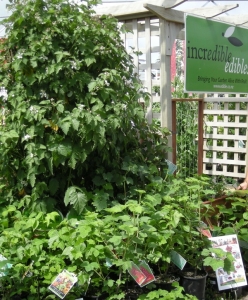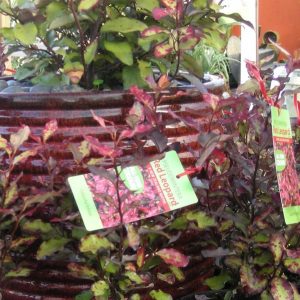Having spent some time working in both New Zealand and Australia within the nursery industry, I was pondering as to what are the two country’s respective strengths and weaknesses in growing and selling plants and how we could learn from each other.

The rise of fruit trees in garden centres has been remarkable
It was said to me that horticulture is one of the few industries that would have a positive spring board from the financial doom and gloom that splatters our papers at disconcerting regularity. I am unconvinced that many of the smaller nurseries I have visit share such beliefs. Many cannot comment anymore about it. Logic suggests that people should choose a somewhat cheaper bottle of Pinot Gris and a pleasant view of the flourishing flower bed and well manicured garden over a trip to the Fijian islands. I wondered therefore why landscapers have become so scarce at the tree and shrub nursery and why people seem to have lost interest in making their house a leafy home?
Do we not care anymore about what lies beyond the decking? Was the landscaping surge of the early 2000s all for money, as people bought property, poured mint sauce on the ‘mutton’ and then sold it as ‘lamb’? We fast forward to 2012 and why bother now? It seems that mutton and lamb have the same value, at least according to the property insert of the local paper. As the spectrum of reasons for the decline of the caring gardener is as vast and colourful as a rainbow, so could reaping the benefits of reaching the pot of gold at the end, if we so care to go searching for the reasons.
Land use is a fundamental issue for the grower’s market. If at the current time there is a surge in any aspect of the industry then it lies in re-veging planting. Large scale motorway planting, shopping centre car parks and entrances to new housing estates demand huge numbers but often are restricted to low maintenance varieties. The demise of the market is therefore more with the decline of plant variety. With the changes to house section space, the infrastructure of urban life paves the way for the type of plant the grower is expected to produce. In Auckland for example, blocks are squeezed into smaller and smaller areas. Paving is the new lawn and sadly everywhere it’s easy care plants that are wanted. Too often unqualified landscapers plan and plant the garden. Planting and designing a garden is a science that needs scientists not cowboys who can use a spade. Careful planning and a good designer will prove their worth.
Changing fashions
What of course is such a challenge to a grower are the changing trends of the customer. They expect a plant to be produced at the same rate as the rotation of fashions. No better example of this in recent times was the rise of the fruit tree. Plums, peaches and pears had suddenly became a fashion icon as if they had just dropped out of the sky. Demand was pulsating. Growers in New Zealand were caught empty handed in stock supplies and knew that years of growing needed to pass before a decent size grafted tree could be produced again. But what if this trend swings again and in three years we have had it with Victoria and her plums? There is no simple answer to this of course and it’s a nightmare for growers to predict. What is much easier to predict is the power of media and as growers we must be glued to the magazines (even fashion magazines for changing trends in colour) and respond. Linda Hallinan, editor-at-large of New Zealand Gardener is quickly becoming the guru and face of vegetable gardening in New Zealand. Readers and viewers react to her every word. Australia needs the same in-your-face iconic figure, so please wherever you are, stand up and tell the grower the latest fashions.
Loyalty begins at home

NZ native Griselinia – a proven native that succeeds at ‘home’
As home-grown produce continues to be driven by Dick Smith et al, loyalty in Australia is still a little wayward with native plants. It makes sense that a survivor of generations should be grown here. We can often force plants to grow where conditions might not favour their survival because we like the flower colour or its leaves or dare I say the colour of the pot it comes in. New Zealand support its natives, garden favourites being the Silverfern, the Griselinia and Coprosmathat reward such faith with great longevity. If colour is the driving force of decision making by the customer, then the choice of natives

Native New Zealand Coprosma ground cover grown in bags
should be a close second.
Growing is easy, selling is a different story

Plants are now often sold with a pot colour that matches the flower or foliage
Once we have the plant right, then we need to sell it. In garden centres the standards of presentation have risen metres since the decline of plant sales. Coloured pots to match that of the plant’s flowers are becoming standard and although plant bags still dominate the woven matting of an Auckland nursery, Australians pretty well grow everything of a smaller scale in hard plastic. Colour coding and hefty label marketing are givens here in Australia and they do it well. The New Zealanders need to sell harder and not assume that a great plant in a plastic bag will sell.
As we all dream of a return to the caring gardener and economic boom, whether here in Australia or in New Zealand, perhaps as Australians we need to trust and embrace our natives more and experiment less. I am sure the good times for our garden centres will return. We just need to give it a go.
